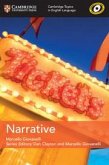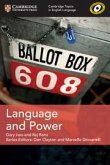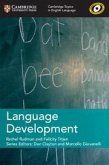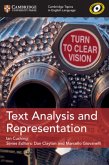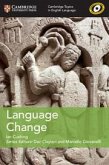Dan Clayton
Cambridge Topics in English Language Attitudes to Language
Herausgeber: Giovanelli, Marcello
Dan Clayton
Cambridge Topics in English Language Attitudes to Language
Herausgeber: Giovanelli, Marcello
- Broschiertes Buch
- Merkliste
- Auf die Merkliste
- Bewerten Bewerten
- Teilen
- Produkt teilen
- Produkterinnerung
- Produkterinnerung
Essential study guides for the future linguist.
Andere Kunden interessierten sich auch für
![Cambridge Topics in English Language Language Diversity and World Englishes Cambridge Topics in English Language Language Diversity and World Englishes]() Dan ClaytonCambridge Topics in English Language Language Diversity and World Englishes29,99 €
Dan ClaytonCambridge Topics in English Language Language Diversity and World Englishes29,99 €![Cambridge Topics in English Language Language and Gender Cambridge Topics in English Language Language and Gender]() Felicity TitjenCambridge Topics in English Language Language and Gender30,99 €
Felicity TitjenCambridge Topics in English Language Language and Gender30,99 €![Cambridge Topics in English Language Narrative Cambridge Topics in English Language Narrative]() Marcello GiovanelliCambridge Topics in English Language Narrative30,99 €
Marcello GiovanelliCambridge Topics in English Language Narrative30,99 €![Cambridge Topics in English Language Language and Power Cambridge Topics in English Language Language and Power]() Gary IvesCambridge Topics in English Language Language and Power30,99 €
Gary IvesCambridge Topics in English Language Language and Power30,99 €![Cambridge Topics in English Language Language Development Cambridge Topics in English Language Language Development]() Rachel RudmanCambridge Topics in English Language Language Development30,99 €
Rachel RudmanCambridge Topics in English Language Language Development30,99 €![Cambridge Topics in English Language Text Analysis and Representation Cambridge Topics in English Language Text Analysis and Representation]() Ian CushingCambridge Topics in English Language Text Analysis and Representation30,99 €
Ian CushingCambridge Topics in English Language Text Analysis and Representation30,99 €![Cambridge Topics in English Language Language Change Cambridge Topics in English Language Language Change]() Ian CushingCambridge Topics in English Language Language Change30,99 €
Ian CushingCambridge Topics in English Language Language Change30,99 €-
-
Produktdetails
- Produktdetails
- Cambridge Topics in English Language
- Verlag: Cambridge University Press
- Seitenzahl: 114
- Erscheinungstermin: 25. Januar 2018
- Englisch
- Abmessung: 228mm x 154mm x 7mm
- Gewicht: 184g
- ISBN-13: 9781108402149
- ISBN-10: 1108402143
- Artikelnr.: 48916771
- Herstellerkennzeichnung
- Libri GmbH
- Europaallee 1
- 36244 Bad Hersfeld
- gpsr@libri.de
- Cambridge Topics in English Language
- Verlag: Cambridge University Press
- Seitenzahl: 114
- Erscheinungstermin: 25. Januar 2018
- Englisch
- Abmessung: 228mm x 154mm x 7mm
- Gewicht: 184g
- ISBN-13: 9781108402149
- ISBN-10: 1108402143
- Artikelnr.: 48916771
- Herstellerkennzeichnung
- Libri GmbH
- Europaallee 1
- 36244 Bad Hersfeld
- gpsr@libri.de
1. Arguments about English: 1.1. How we feel about language
1.2. Standard English
1.3. Non-Standard English
1.4. The origins of Standard English
1.5. The development of Standard English
1.6. Complaints about English
1.7. Changing English
2. Technology and language: 2.1. Technology and language change
2.2. Technology and new words
2.3. Attitudes to texting
2.4. Attitudes to other forms of CMC
2.5. Emoji
3. Attitudes to language variation: 3.1. Variation: what it is and what it ain't
3.2. Attitudes to regional variation
3.3. Attitudes to other varieties
4. Language discourses: 4.1. Analysing language discourses
4.2. Describing language
4.3. A language toolkit
4.4. Further exploration and investigation
Ideas and answers
References.
1.2. Standard English
1.3. Non-Standard English
1.4. The origins of Standard English
1.5. The development of Standard English
1.6. Complaints about English
1.7. Changing English
2. Technology and language: 2.1. Technology and language change
2.2. Technology and new words
2.3. Attitudes to texting
2.4. Attitudes to other forms of CMC
2.5. Emoji
3. Attitudes to language variation: 3.1. Variation: what it is and what it ain't
3.2. Attitudes to regional variation
3.3. Attitudes to other varieties
4. Language discourses: 4.1. Analysing language discourses
4.2. Describing language
4.3. A language toolkit
4.4. Further exploration and investigation
Ideas and answers
References.
1. Arguments about English: 1.1. How we feel about language
1.2. Standard English
1.3. Non-Standard English
1.4. The origins of Standard English
1.5. The development of Standard English
1.6. Complaints about English
1.7. Changing English
2. Technology and language: 2.1. Technology and language change
2.2. Technology and new words
2.3. Attitudes to texting
2.4. Attitudes to other forms of CMC
2.5. Emoji
3. Attitudes to language variation: 3.1. Variation: what it is and what it ain't
3.2. Attitudes to regional variation
3.3. Attitudes to other varieties
4. Language discourses: 4.1. Analysing language discourses
4.2. Describing language
4.3. A language toolkit
4.4. Further exploration and investigation
Ideas and answers
References.
1.2. Standard English
1.3. Non-Standard English
1.4. The origins of Standard English
1.5. The development of Standard English
1.6. Complaints about English
1.7. Changing English
2. Technology and language: 2.1. Technology and language change
2.2. Technology and new words
2.3. Attitudes to texting
2.4. Attitudes to other forms of CMC
2.5. Emoji
3. Attitudes to language variation: 3.1. Variation: what it is and what it ain't
3.2. Attitudes to regional variation
3.3. Attitudes to other varieties
4. Language discourses: 4.1. Analysing language discourses
4.2. Describing language
4.3. A language toolkit
4.4. Further exploration and investigation
Ideas and answers
References.




